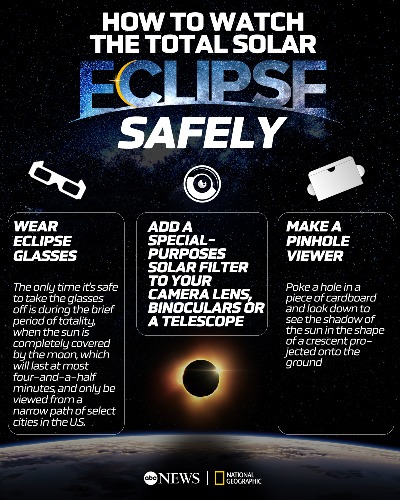
As the anticipation builds for the upcoming total solar eclipse, ABC News and National Geographic prepare to provide premiere coverage with “Eclipse Across America,” airing live on Monday, April 8 at 2:00 p.m. EDT on ABC, ABC News Live, National Geographic Channel, Nat Geo WILD, Disney+, and Hulu, as well as network social media platforms.
National Geographic Explorer and Astrophysicist Ved Chirayath will be on site for this coverage to show viewers how to safely observe and photograph eclipses and break down the science and history behind them. From detecting an extra-solar planet as a high school sophomore to being a finalist for the NASA Astronaut Candidate Class of 2021, Chirayath’s expertise and knowledge on April 8th will be unparalleled.
Innovation & Tech Today spoke with Chirayath to discuss what type of tech is used to study solar eclipses, the potential tech for future celestial events such as this, research opportunities, and more.
Innovation & Tech Today: Can you explain how drones and satellites are used to study solar eclipses?
Ved Chirayath: We have the ability to observe the sun 24/7 using a satellite called the Solar Dynamics Observatory. It’s a satellite that was launched in the early 2000s with a continuous view of the sun and the solar weather it generates. The satellite looks at the sun in different colors, and we’re able to then predict when there’s going to be large solar flares or prominences because we’re seeing it in real-time.
When it comes to drones with airborne observations, they’ve also provided a ton of data on what goes on on Earth during the eclipse. You can see pictures of the moon’s shadow going across the planet, both from aircraft and from satellites that are observing the Earth’s surface, and that can be used to do a lot of satellite calibrations and measurements.
I&T Today: What kind of tech do you expect we will use for future solar eclipses?
Chirayath: A total eclipse is somewhat of a random occurrence. The moon does not need to be the size that it is at the distance it is. Right now, we’re having a total eclipse where it manages to block out perfectly the solar disk, which is a rarity. And the moon will not always be like this. The moon is moving away around four centimeters every year, and eventually, there will be no more total eclipses.
But one of the technologies that’s been inspiring is the development of a coronagraph that allows us to block out starlight and look at a star as our atmosphere, which is long and extended. That type of technology is now being developed to look for planets and other solar systems by blocking out starlight from the host stars of those planetary systems, and then ideally trying to direct image exoplanets and discover any planets using.
I&T Today: What challenges do scientists face in capturing data during a solar eclipse?
Chirayath: A lot of astronomy is not an easy science. I sort of straddle space exploration and Oceanography, and both are some of the most challenging things to do. But for one, we’re looking at the weather forecasting models. And I’m hoping it will not be cloudy in Texas, which is where I’m traveling to capture the eclipse. That’s one big challenge- you get what nature gives you.
The second is you’ll practice, you’ll set up your equipment, and all of that has to work perfectly for this period of time. It’s a lot of pressure.

I&T Today: What safety precautions should individuals take when observing the eclipse? How can special viewing equipment help people safely see a solar eclipse?
Chirayath: I would never look at the sun directly with the unaided eye- it is an incredibly bright object. Humans have evolved to have a response where we tend to look away from bright objects. But unfortunately, our brains are so powerful that we can force our eyes to look at them, and one should not do that. In fact, during the last eclipse, there were a lot of cases of people having images of the eclipse permanently burned into their retinas, and they see it 24/7.
Eclipse glasses should come from a certified vendor that provides the right amount of light transmission. Eclipse glasses tend to look like a piece of mylar film that is silver in color and mounted in a cardboard frame. If you’re in the path of complete totality and you see the sky go completely dark, for that moment, it’s okay to look at the sun without eclipse glasses. So we highly encourage people to take off their glasses and look up, but be very careful. The minute you see the sun peeking out again from the side of the moon, you will need to put your glasses back on.
Another safe way of viewing it is by using a camera obscura or pinhole camera. You can take a cardboard box, like a shipping box, with a small pinhole in it. If you look into that box and point the pinhole at the sun, you’ll see a projection of the sun onto that box. It’s a great way to photograph the sun if you have a camera phone. You can put it inside that box and take a picture- you’ll see some sunspots and the moon as it’s progressing across the solar disk.
Also, trees have these leaves that form these natural pinholes. It’s happening 24/7, but we don’t normally notice it because the sun is a sphere, so the objects it’s casting on the ground are little spherical shapes. But, if you look during the eclipse, you’ll see the crescent of the moon occulting the solar disk, and suddenly you’ll see thousands of moons projecting onto the ground if you’re by trees with leaves rustling around.
I&T Today: What scientific research opportunities does this eclipse present for astronomers and astrophysicists?
Chirayath: One thing I ask people to look out for are solar flares and prominences. These are pieces of the photosphere of the sun that are incredibly hot plasmas that are shooting off of the sun and arcing around, three times the size of Earth or larger, and they’re moving at a speed that you can visually see, which is quite astonishing. People think of the universe as this very static place, but it’s not.
Another research opportunity is with the solar corona. We also call it the photosphere of the sun. So the sun is a big object, it’s around 1,000 Earths in size, and some dynamics are occurring on this body in real-time that you can see if you have a solar telescope, but if you don’t, you only really see it during a total eclipse.
Scientists are excited to study this because it’s still quite poorly understood. The temperature of the solar corona is around a million degrees Kelvin, compared to the surface of the sun, which is only about 6,000 degrees Kelvin. And that’s a counterintuitive thing. So, scientists are eager to study this by using different properties of light. We look at the color of light and polarizations of how the light is tilted. That’s one of NASA’s campaigns- using citizen scientists to make observations of the polarization of that corona to understand a little bit more of the physics that’s going on in our closest star.
I&T Today: What can our readers expect from ABC News and National Geographic’s ‘Eclipse Across America’ and why should they tune in?
Chirayath: It’s one of the most exciting events in human history because it brings everybody together in a unique way. It ties us to nature in a very special way. So, when I think they look at the program, they’ll get to see multiple different cultures, people, and places celebrating the same event, really getting a spectacle of what your universe has to offer and how it does not discriminate based on who you are, where you are, what color you are, or what kind of background you come from. It’s easily accessible to everybody.











